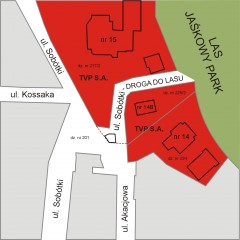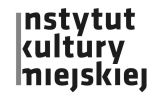Julita Wójcik
way to the forest
site-specific installation made of garden lamps, 2014
In her artistic practice Julita Wójcik often refers to daily activities which do not trigger immediate associations with art but rather evoke the experience of everyday life, slightly reminiscent of the bygone days, which are slowly being forgotten. Her activities usually betray a dual character. They include a rational element (arranging the surroundings, supporting a social idea), while they also adopt the form of irrational performances or symbolic installations.
It is similar with her project way to the forest, in which the artist “restores” a path to the forest in Wrzeszcz by temporarily lighting the way, or rather its trajectory, with garden lamps. The path marks the administrative division between two plots in 14 and 15 Sobótki Street, in the vicinity of the artist’s house. Yet, in reality, it does not exist because the area is occupied by a public TV station, although it is not its owner. As a result, there is no way through. The forest has been cut off.
As a local, Julita knows best how strange it is to live next to a forest without having access to it. Her gesture is intended to spark a social debate, which is to lead to opening the path for everybody.
Is Julita a good spirit of the place? She suggests a simple solution which can make many people happy. The essence of this place is the very forest right behind the house.
Julita Wójcik (b. 1971), live and works in Gdańsk.
Julita Wójcik is famous for daily activities which do not trigger immediate associations with art but rather evoke the experience of everyday life. She deals with crocheting, sweeping the floor, gardening, making miniponds, building birdfeeders, or flying kites – these simple activities acquire importance only when they enter the artistic context, which ennobles them on the one hand, while on the other – deprives art of its elitist value. Seemingly mundane projects like Peeling Potatoes (2001) or caring tenderly for a garden (My Garden, Gdynia, 2000) can spark a debate about the borders of art, which, as it is commonly believed, should not approach daily life at such a dangerous distance. Julita often simply deprives art of gravity as charmingly as a little girl who allows colourful balloons to hover above the city (Castle Reconstruction Kostrzyn, 2004). Her ideas rise above the martyrological burden of places and symbols, often playing with the fire of history. Wójcik’s art reclaims the innocence of places for a short while, but sometimes the result is quite opposite, for example when Rainbow (2012), a large sculpture of flowers modelled on a childlike drawing, appears on Saviour Square in Warsaw and with time sparks a real social storm. The artist launches a play on the place, time and Polish sentiments. The more innocent the game appears, the more often it wakes up demons.
Julita Wójcik is a graduate of the Faculty of Sculpture of the Academy of Fine Arts in Gdańsk. In 2013, she was awarded the Royal Scottish Academy Award and the “Passport” prize of the weekly “Polityka”. She received a scholarship of the Culture Foundation in 2001. Resident at Art in General in New York (USA) in 2006 or Visegrad Fund 2010. Her works form part of public collections.




